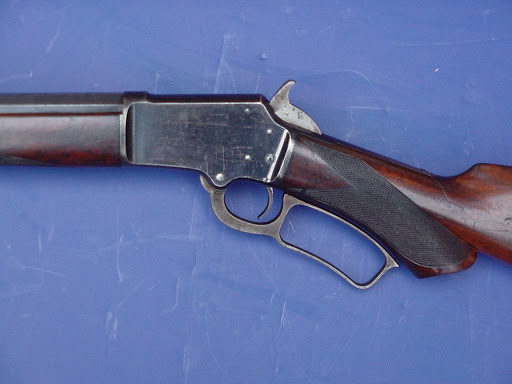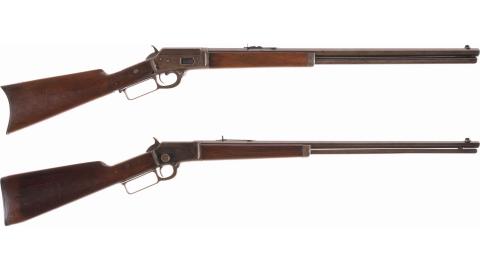ANOTHER ACCIDENTAL AFFLICTION
 On March 10, 1893, Annie Oakley put on a brief but highly memorable demonstration of her shooting skill. She fired 25 shots in 27 seconds from a lever-action .22 rifle, punching one ragged hole in the middle of an ace of hearts. It became one of the most famous playing cards in history. Her rifle was a Marlin Model 1891, and Miss Oakley, the rifle, and that ace of hearts appeared in Marlin ads for years to come.
On March 10, 1893, Annie Oakley put on a brief but highly memorable demonstration of her shooting skill. She fired 25 shots in 27 seconds from a lever-action .22 rifle, punching one ragged hole in the middle of an ace of hearts. It became one of the most famous playing cards in history. Her rifle was a Marlin Model 1891, and Miss Oakley, the rifle, and that ace of hearts appeared in Marlin ads for years to come.
Not only that, it gave the name “Annie Oakley” to free theatre tickets — so-called because they have a hole punched in them to prevent resale — a term that is used to this day.
The Marlin 1891 was the first serious lever-action .22, designed for Marlin by the famous L.L. Hepburn, of Remington-Hepburn fame. It was the foundation of an evolving series that became the best-selling .22 in history — the Marlin Models 39 (1921) and 39A (1939).
As Miss Oakley demonstrated, there was nothing whatever wrong with the original Model 1891. She continued to use it in her performances for years, along with several other Marlin rifles, including an elaborate Model 1897 lever-action .22, presented to her by the company in 1906. This was a period of intense competition among rifle companies, complete with advertising campaigns and gimmicks worthy of (and, in fact, inspired by) P.T. Barnum. Marlin knew it had a winner in the 1891, but it also knew there was room for improvement, and those improvements would have to be made if they were to keep up with Winchester, Remington, and the upstart Arthur W. Savage.
The original Hepburn design had a removable sideplate on the action, held in place by a thumbscrew. This was important in an age when corrosive priming and powders made bore cleaning critical. In 1897, Hepburn expanded on the idea by turning the rifle into a takedown, employing the same thumbscrew. The other major improvement was a tubular magazine that could be loaded from the front, rather than being fed through the action.
The 1892 (sideplate) and 1897 (takedown) rifles remained in the Marlin line until 1916, when all civilian production was halted. The company changed hands, embarked on war production, changed hands again, and only returned to making hunting and target rifles in the early 1920s. The 1892 never went back into production, but the 1897 did, redesignated the Model 39.
One thing that set these Marlin rifles apart from other .22s was the high quality of steel and walnut used in their production. These were the same materials used in their high-powered hunting rifles, and it gave the 1891/92/97 line the “real rifle” feel that every writer has mentioned ever since. They lasted, seemingly, forever, with few broken parts, and were renowned for their accuracy (as Miss Oakley so ably demonstrated).
As so often happens, my interest in the Model 39 occurred accidentally. At Rock Island last year, I was searching for a suitable Savage 99 in .303 Savage for a reloading project. A nice one was paired as a lot with a Marlin 39, so I ended up with both. It turned out that the 39 was not a later reproduction of an early rifle, as listed, but in fact an early rifle expertly restored. It feels, handles, and operates every bit as well as all the magazine articles from the last hundred years insist.
As an experiment, I loaded 25 .22 Shorts into the tubular magazine, stood back 15 yards from an eight-inch plate (Miss Oakley was 12 yards from that ace of hearts), started a timer and began shooting. I got off all 25 rounds in 45 seconds, but I missed the plate completely half a dozen times. The rifle, however, functioned to perfection. I put another 150 rounds through it, some Shorts, some Long Rifles, and it never missed a beat. No jams, no failures.
The Marlin Model 39 (and 39A) holds the record for the longest continuous production of any shoulder firearm, with an estimated 2.2 million made since 1891, and it is still available, although only as a custom-shop order. The listing says that “supplies are limited,” which suggests they are making them up from existing parts, and when those run out, the life of the Marlin 39A will come to an end. That would be sad, for it is one of the truly great American rifles.–Terry Wieland


